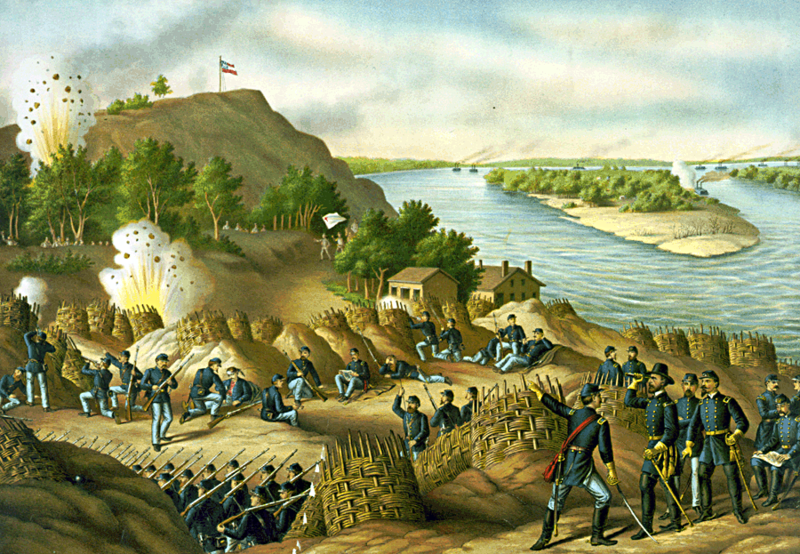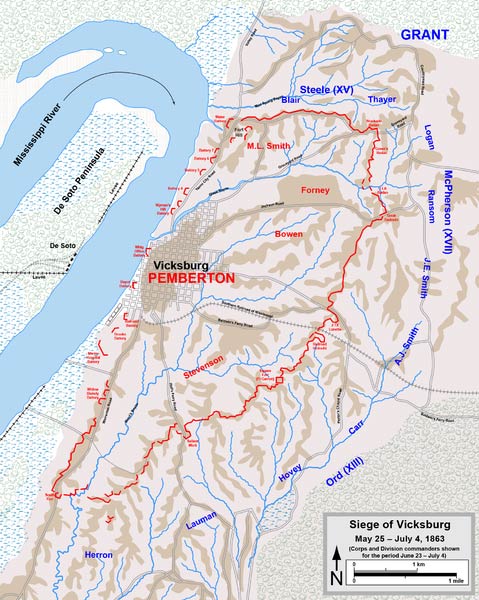| Siege of Vicksburg | |||||||
|---|---|---|---|---|---|---|---|
 |
|||||||
|
|||||||
| Contenders | |||||||
| Military Leaders | |||||||
| Ulysses S. Grant | John C. Pemberton | ||||||
| Military Units in Battle | |||||||
| Army of the Tennessee | Army of Vicksburg | ||||||
| Unit Strength | |||||||
| 77,000 | ~33,000 | ||||||
| Casualties and Deaths | |||||||
| Total: 4,835 | 3,202 killed or wounded | ||||||
| 29,495 captured | |||||||
| Part of the American Civil War | |||||||
The Siege of Vicksburg, which occurred between May 18 to July 4, 1863, was the last major military action in Vicksburg Campaign of the American Civil War. In a sequence of maneuvers, General Ulysses Grant and his Union Army crossed the Mississippi River and forced the Confederate army led by General John C. Pemberton into the defensive lines bordering the fortress city of Vicksburg.
It should be noted that, before the Civil War, the Mississippi River was the most important commercial artery in the U.S., and the main route for cotton trade. However, the civil war blocked the Mississippi to northern trade. The Union therefore was determined to open the river and restore the trade.
By late 1862, a stretch running between Vicksburg, Mississippi and Port Hudson, was the only one that was blocked to North Ships. All in all, Vicksburg was the most powerful barrier on the river.
Before the Siege
Vicksburg was protected by geography, with the Mississippi creating a wide, wet, swampy valley with clear edges and higher dry grounds meeting the swamp. General Grant, whose objective was to capture Vicksburg, was facing a major challenge of getting his army to the dry ground. He had tried to bypass Vicksburg in some earlier attempts, with each ending in failure. In the meantime, Grant’s reputation in the North was in serious danger by the Spring of 1863. So Grant had to act sooner rather than later.
On April 16, 1863, a gala ball was held in Vicksburg for the celebrations of the lifting of the Union threat. However, the party was cut short by roar of gunfire on the river from the gun batteries. This was something which Grant could take advantage of in his quest. Pemberton had more than 30,000 men, therefore Grant would face an army which was almost equal in number to his own.
Between May 7 and 18, Grant launched a skillful campaign called Big Black River Campaign. He moved his troops along the line of Big Black River and separated Pemberton from the troops which were being assembled at Jackson. On May 18, Pemberton’s men trooped back into Vicksburg after losing over 5,000 men.
The Siege of Vicksburg
 On May 19, Grant’s troops arrived in front of the defenses of Vicksburg, and General Grant decided to initiate an immediate assault on Vicksburg. However, the Confederates had spent most of the last seven months constructing strong defenses. It’s for this reason that Grant’s attack were repulsed even after Pemberton had suffered 2 serious defeats in the last 3 days.
On May 19, Grant’s troops arrived in front of the defenses of Vicksburg, and General Grant decided to initiate an immediate assault on Vicksburg. However, the Confederates had spent most of the last seven months constructing strong defenses. It’s for this reason that Grant’s attack were repulsed even after Pemberton had suffered 2 serious defeats in the last 3 days.
The Union launched a second attack which was carefully prepared, but Pemberton’s defenses repulsed the attack once again. Grant was worried that Confederate General Johnson was still increasing the size of his army gradually.
Even with strong defenses, Vicksburg was hoping that Johnston or another Confederate commander would come to the aid of the city. Still, the troop shortage at that time was beginning to plague the Confederacy.
Earlier, Braxton Bragg had dispatched 2 divisions to the west, weakening his troops at a crucial time. Although Robert Lee had the most available troops, he could not assist in the situation since he was about to invade the north for the second time and could not send some of his men to the west at the time.
However, General Richard Taylor, who was commanding in Louisiana at the West of Mississippi, sent 3 brigades to attack Grant’s supply line. This expedition was defeated on June 7, 1863, at Milliken’s Bend. The defenders’ of Vicksburg only hope was for Johnston to come to their aid.
Johnston was not in a good position to assist at that time, since he had 30,000 men in his army. He was poorly equipped, had no proper transport and most of his men were inexperienced. As Johnston’s troop grew bigger, so did Grant’s. Grant’s army grew to 70,000 and surrounded Vicksburg, with 7 groups facing east under the leadership of Sherman, to deal with any counterattack from Confederates.
Throughout June, Grant’s men built a series of trenches in a classical siege operation. These trenches snuck closer and closer and under the Confederate lines. Mines were also exploded, with the first one exploding on June 25, and creating a big crater. However, the defenders of the city had already detected it and built a second line of defense further back.
Another attack from the Union troops was repulsed with heavy losses. The second mine was exploded on July 1, and shattered a Confederate fort although it was not followed by an immediate assault. Grant was planning to wait until a time he could explode several mines simultaneously, and use the confusion to launch a general attack along the line. He set the D-Day at July 6.
The Surrender
In the end, Grant did not require any attack since food was already running low inside Vicksburg. On June 28, General Pemberton received an anonymous note from amongst his men, requesting him to surrender before the army could abandon him. Pemberton would then consult with his senior officers on July 1, with the possibility of fighting their way through the Federal line. However, he was informed that his men were not physically capable of making the attempt. On the morning of July 3, Pemberton ordered the raising of white flags on the Confederate defenses, meaning that he was ready to surrender. Pemberton and Grant met between the lines at around 3:00 pm on the same day. However, the meeting did not go well since Grant wanted an unconditional surrender, which Pemberton refused.
Grant went back and discussed the terms with his corps commanders. After the meeting, Grant revised the terms and this time he would allow Confederate troops to leave Vicksburg after giving their parole not to fight again. These terms had two main intentions: to reduce the stress on Grant’s supply lines, and Grant hoped that 30,000 disaffected ex-soldiers strolling around the Confederacy would do a great deal of harm to morale. At the night of July 3, Pemberton agreed to the terms and the following day was Independence Day. All in all, 2,166 officers as well as 27,230 men surrendered at Vicksburg and within several weeks, they were scattering across the south. The surrender quickly prompted to the surrender of Port Hudson, which was the last Confederate stronghold on the Mississippi.